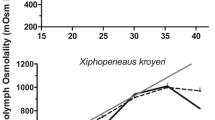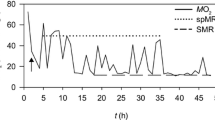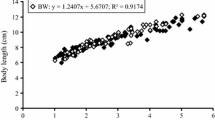Summary
Oxygen consumption, gill ventilation, blood acid-base/ionic status and haemoglobin oxygen affinity were studied in seawater-adapted adult salmon (Salmo salar) during five weeks after transfer into fresh water. Freshwater exposure induced the following changes: Standard oxygen consumption (\(\dot M_{O_{ 2} } \)) and ventilatory flow (\(\dot V_w \)) decreased markedly during the first days after transfer, then decreased more gradually until a new steady-state was achieved at which \(\dot M_{O_{ 2} } \) and \(\dot V_w \) were about 80% and 56% of the control values, respectively. The marked increase in oxygen extraction coefficient (Ew O 2) and the marked decrease in the oxygen convection requirement (\(\dot V_w /\dot M_{O_{{\text{ 2}}} } \)) were associated with a reduction in the partial pressure of carbon dioxide in arterial blood (Pa CO 2), in spite of a decrease of both ventilatory flow and water CO2 capacitance. These results suggested that transfer into fresh water induced an increase in branchial diffusive conductance. A biphasic pattern was observed in the time-course of the changes in both plasma ion concentration and acid-base status. During the first 10 days, plasma Na+, K+, and Cl− concentrations fell abruptly, then more gradually. [Cl−] decreased more than [Na+] resulting in a progressive increase in the [Na+]/[Cl−] ratio. During the second phase of acclimation to fresh water plasma Na+, K+, and Cl− concentrations progressively increased. [Cl−] increased more than [Na+], so that [Na+]/[Cl−] ratio decreased. Transfer into fresh water did not significantly change plasma lactate concentration. Upon exposure to fresh water, blood pH increased from 7.94±0.04 to 8.43±0.06 at day 10 and then decreased to 8.08±0.03 at day 34. The increase in blood pH induced by transfer to fresh water initially represented a mixed metabolic/respiratory alkalosis. However, after 15 days Pa CO 2 had returned to pretransfer values and the alkalosis was purely metabolic. The metabolic component of the alkalosis was associated with appropriate changes in the plasma strong ion difference (S.I.D.). Blood alkalosis moved the oxygen dissociation curve to the left, so that P50 was decreased by 30% below the value in seawater for the maximal increase in blood pH. This rise in haemoglobin affinity for O2, associated with a marked increase in blood buffer capacity, are regarded as adaptative processes allowing the salmon to cope with the markedly increased energy expenditure required for upstream migration.
Similar content being viewed by others
References
Bath RN, Eddy FB (1979a) Ionic and respiratory regulation in rainbow trout during rapid transfer to seawater. J Comp Physiol 134:351–357
Bath RN, Eddy FB (1979b) Salt and water balance in rainbow trout (Salmo gairdneri) rapidly transferred from fresh water to sea water. J Exp Biol 83:193–202
Brunori M, Falcioni G, Fortuna G, Giardina B (1975) Effects of anions on the oxygen binding properties of the hemoglobin components from trout (Salmo irideus). Arch Biochem Biophys 168:512–519
Christoforides C, Hedley-Whyte J (1969) Effect of temperature and haemoglobin concentration on solubility of O2 in blood. J Appl Physiol 27:592–596
Claireaux G, Thomas S, Fievet B, Motais R (1988) Adaptative respiratory responses of trout to acute hypoxia. II. Blood oxygen carrying properties during hypoxia. Respir Physiol 74:91–98
Dejours P (1973) Problems of control of breathing in fishes. In: Comparative Physiology (eds L Bolis, K Schmidt-Nielsen and SHP Maddrel). North Holland Company, pp 117–133
De Renzis G, Maetz J (1973) Studies on the mechanism of chloride absorption by the goldfish gill. Relation to acid-base regulation. J Exp Biol 59:339–358
Evans DH (1984) The roles of gills permeability and transport mechanisms in euryhalinity. In: Fish Physiology, vol. XB (eds WS Hoar & DJ Randall), Academic Press, Toronto, pp 105–125
Farrell AP, Lutz PL (1975) Apparent anion inbalance in the freshwater adapted eel. J Comp Physiol 102:159–166
Heisler N (1984) Acid-base regulation in fishes. In: Fish Physiology. vol 10, Pt A (eds WS Hoar & DJ Randall). Academic Press, London New York, pp 315–401
Holmes WN, Donaldson EM (1969) The body compartments and the distribution of electrolytes. In: Fish Physiology (WS Hoar and DJ Randall eds), vol 1, Academic Press, New York, pp 1–89
Hughes GM, Shelton G (1958) The mechanism of gill ventilation in three freshwater teleostean fishes. J Exp Biol 35:807–823
Isaia J (1984) Water and nonelectrolyte permeation. In: Fish Physiology, vol Xb, Hoar WS, Randall DJ (eds). Academic Press, pp 1–38
Lahlou B, Crenesse D, Bensahla-Talet A, Porthe Nibelle J (1975) Adaptation de la truite d'élevage à l'eau de mer. Effets sur les concentrations plasmatiques, les échanges branchiaux et le transport intestinal du sodium. J Physiol, Paris, 70:593–603
Laurent P (1984) Gill internal morphology. In: Fish Physiology, vol. X, Part A. (WS Hoar & DJ Randall eds), Academic Press, New York, pp 73–183
Madan Moan Rao G (1968) Oxygen consumption of rainbow trout (Salmo gairdneri) in relation to activity and salinity. Can J Zool 46:781–786
Madan Moan Rao G (1971) Influence of salinity and activity on the weight-dependent oxygen consumption of rainbow trout. Mar Biol 8:401–415
Maxime V, Soulier P, Quentel C, Aldrin JF, Peyraud C (1986) Comparative study of oxygen consumption and blood parameters in rainbow trout (Salmo gairdneri R) and brown trout (Salmo trutta L), both in fresh water and sea water during summer increase of water temperature. Ichtyophysiologica Acta 10:185–200
Milne RS, Randall DJ (1976) Regulation of arterial pH during freshwater to seawater transfer in the rainbow trout (Salmo gairdneri). Comp Biochem Physiol 53A:157–160
Nonnotte G, Kirsch R (1978) Cutaneous respiration in seven seawater teleosts. Respir Physiol 35:111–118
Payan P, Girard JP, Mayer-Gostan N (1984) Branchial ion movements in teleosts: the roles of respiratory and chloride cells. In: Fish Physiology, vol. XB (eds WS Hoar & DJ Randall). Academic Press, Toronto, pp 39–59
Perry SF (1986) Carbon dioxide excretion in fishes. Can J Zool 64:565–572
Perry SF, Heming TA (1981) Blood ionic and acid-base status in rainbow trout (Salmo gairdneri) following rapid transfer from freshwater to seawater: Effect of pseudobranch denervation. Can J Zool 59:1126–1132
Perry SF, Davie PS, Daxboeck C, Randall DJ (1982) A comparison of CO2 excretion in a spontaneously ventilating blood-perfused trout preparation and saline-perfused gill preparations: Contribution of the branchial epithelium and red blood cell. J Exp Biol 101:47–60
Potts WTW (1984) Transepithelial potentials in fish gills. In: Fish Physiology, vol Xb, Hoar WS, Randall DJ (eds). Academic Press, pp 105–128
Potts WTW, Talbot C, Eddy FB (1985) Sodium balance in freshrun Atlantic salmon. J Exp Biol 118:455–460
Randall DJ, Daxboeck (1984) Oxygen and carbon dioxyde transfer across fish gills. In: Fish Physiology, vol. X, part. A (WS Hoar and DJ Randall eds), Academic Press, New York, pp 263–314
Severinghaus JW, Stupfel M, Bradley AF (1956a) Accuracy of blood pH and PCO 2 determinations. J Appl Physiol 9:189–196
Severinghaus JW, Stupfel M, Bradley AF (1956b) Variations of serum carbonic acid pK′ with pH and temperature. J Appl Physiol 9:197–200
Sigaard-Andersen O (1963) The acid-base status of the blood. Scand J Clin Lab Invest 15 (Suppl) 70:1–134
Smatresk NJ, Cameron JN (1982) Respiration and acid-base physiology of the spotted gar, a bimodal breather. III. Response to a transfer from fresh water to 50% sea water, and control of ventilation. J Exp Biol 96:295–306
Soivio A, Nyholm K, Westman K (1975) A technique for repeated sampling of the blood of individual resting fish. J Exp Biol 62:207–217
Steffensen JF, Lomholt JP (1983) Energetic cost of active branchial ventilation in the sharksucker, Echeneis naucrates. J Exp Biol 103:185–192
Tetens W, Lykkeboe G (1985) Acute exposure of rainbow trout to mild and depp hypoxia: blood P50 and O2. Repir Physiol 61:221–235
Thomas S, Fievet B, Barthelemy L, Peyraud C (1983) Comparison of the effects of exogenous and endogenous hypercapnia on ventilation and oxygen uptake in the rainbow trout (Salmo gairdneri R.). J Comp Physiol 151:185–190
Truchot JP (1974) Le transport des gaz respiratoires (oxygene et dioxyde de carbone) par le sang du Crabe Carcinus maenas. Thèse de Doctorat d'Etat, Paris, p 267
Truchot JP (1987) Comparative aspects of extra cellular acid-base balance. Zoophysiology, vol. 2 (Ed Burggren W, Ishii S, Johansen K, Langer H, Newweiler G, Randall DJ) p 248. Springer, Berlin Heidelberg New York
Wilkes PRH, McMahon BR (1986) Responses of a stenohaline freshwater teleost (Catostomus commersoni) to hypersaline exposure. I. The dependance of plasma pH and bicarbonate concentration on electrolyte regulation. J Exp Biol 121:77–94
Wood SC, Johansen K (1973) Blood oxygen transport and acidbase balance in eels during hypoxia. Am J Physiol 225:849–851
Wood CM, McDonald D, McMahon BR (1982) The influence of experimental anaemia on blood acid-base regulation in vivo and in vitro in the starry flounder (Platichthys stellatus) and rainbow trout (Salmo gairdneri). J Exp Biol 96:221–237
Author information
Authors and Affiliations
Rights and permissions
About this article
Cite this article
Maxime, V., Peyraud-Waitzenergger, M., Claireaux, G. et al. Effects of rapid transfer from sea water to fresh water on respiratory variables, blood acid-base status and O2 affinity of haemoglobin in Atlantic salmon (Salmo salar L.). J Comp Physiol B 160, 31–39 (1990). https://doi.org/10.1007/BF00258760
Accepted:
Issue Date:
DOI: https://doi.org/10.1007/BF00258760




